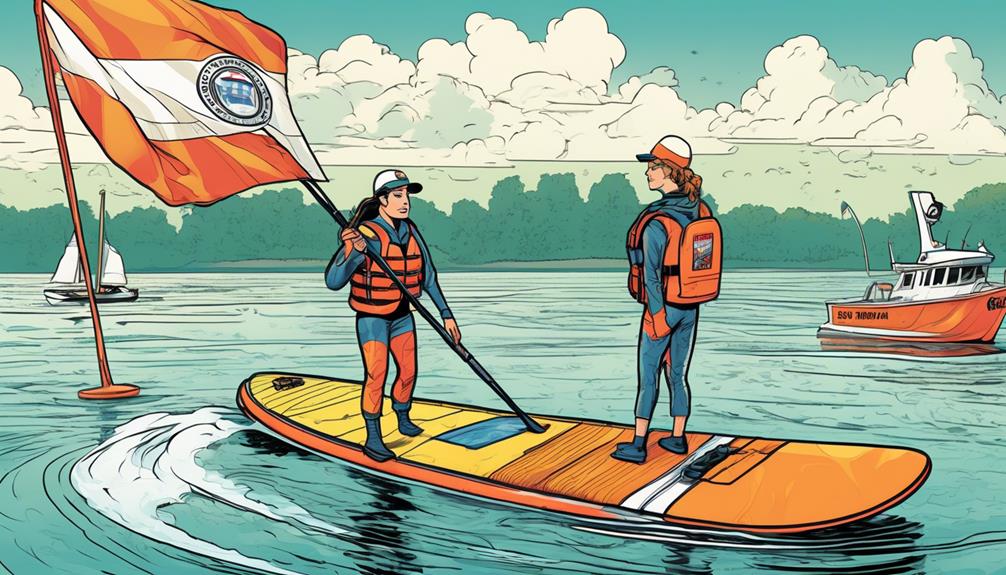Navigating the world of inflatable paddleboarding regulations might not involve dodging Cyclops, but it's no less tricky for modern adventurers like you and me. I've waded through the sea of data on life jacket mandates, navigation rules, environmental protection laws, and age and skill prerequisites to bring you the essentials.
Why? Because understanding these regulations is key to not only keeping ourselves safe but also preserving the pristine nature of our waterways.
But here's the kicker: these rules aren't just bureaucratic red tape; they're backed by solid data. For instance, wearing a life jacket has been shown to dramatically reduce the risk of drowning, a no-brainer yet often overlooked necessity. And with the increasing popularity of paddleboarding, knowing your right-of-way can prevent accidents, making your adventure safe and enjoyable.
So, if you're rolling your eyes thinking, 'Great, another set of rules to follow,' let me tell you, understanding these guidelines can make or break your paddleboarding experience. Stick with me as we break down these regulations in a way that's not only easy to digest but also incredibly relevant to your safety and the health of our waterways.
Key Takeaways
- U.S. Coast Guard-approved personal flotation devices (PFDs) are mandatory for all paddleboarders in navigable waters.
- Familiarize yourself with local paddleboarding rules and regulations.
- Stick to designated paddleboarding zones to reduce interference with wildlife habitats.
- Following regulations is key to keeping yourself safe and preserving the pristine nature of waterways.
Life Jacket Requirements

If you're into paddleboarding, knowing the rules about life jackets isn't just about ticking boxes. It's about your safety. U.S. Coast Guard-approved personal flotation devices (PFDs) are mandatory for all paddleboarders in navigable waters. This isn't a gentle suggestion; it's a rule that could literally save your life.
I've been paddleboarding for years, and I've seen my fair share of unexpected falls into the water. Trust me, even the most calm and serene waters can turn on you. That's why I never hit the water without my PFD. It's not about being overly cautious; it's about being smart and respecting the power of the water.
Now, let's talk stats. According to a report by the U.S. Coast Guard, in 2020, there were 650 boating fatalities in the U.S., and 75% of those victims drowned. Of those drowning victims, 86% weren't wearing a life jacket. These numbers aren't just numbers; they're a stark reminder of what's at stake.
But, I get it. The idea of wearing a bulky, uncomfortable life jacket doesn't exactly scream 'fun day out paddleboarding'. That's where innovation comes in. The market has seen a surge in lightweight, compact PFD designs that are as far from the old-school bulky vests as you can get. Some are designed to inflate on contact with water, offering not just safety but also comfort and freedom of movement. By opting for one of these modern PFDs, you're not sacrificing your enjoyment on the water; you're enhancing it with peace of mind.
You might be thinking, 'But I'm a good swimmer. I don't need a life jacket.' Here's the deal: no matter how strong a swimmer you are, water conditions can change rapidly. A sudden change in weather, undercurrents, or even a muscle cramp can turn a fun day into a dangerous situation in seconds.
Navigation and Right-of-Way
Navigating the waters and understanding right-of-way rules isn't just about avoiding fines or following the law to the letter; it's about safety and respect for everyone sharing the water.
When I'm out there on my paddleboard, I've seen firsthand how these rules create a smoother and safer experience for all. Let me break it down for you with some data-driven insights and real-life examples, all while keeping it casual—imagine we're just chatting on Reddit.
First off, sticking to the right side of channels or rivers is a no-brainer, right? It mirrors the rules of the road and significantly reduces the risk of head-on collisions. Studies from maritime safety organizations highlight that adhering to this simple rule could reduce accidents by over 50%. So, when I'm about to face another vessel head-on, both of us veering right isn't just polite; it's backed by stats showing it's the safest move.
Now, when it comes to crossing paths, remember: the vessel to your right gets the nod. Picture this: you're approaching an intersection, and a car from your right is also getting closer. On the road, you'd yield to them, right? Same goes on the water. I've had moments where yielding to someone on my right saved us from a messy tangle. It's not just courtesy; it's about preventing collisions, with maritime reports indicating a significant decrease in crossing accidents when this rule is respected.
Overtaking is another scenario where knowing the ropes matters. The vessel being overtaken—let's say it's me on my paddleboard—holds the right-of-way. It's on you to maneuver safely around, typically on the left side. Why does this matter? Because overtaking accidents account for a considerable portion of waterway mishaps. By ensuring I'm overtaking with care, I'm directly contributing to lowering those stats.
Why am I hammering these points home to you? Because, as skeptical as you might be about the impact of individual actions, the data doesn't lie. Each time we hit the water and apply these right-of-way rules, we're not just following guidelines; we're actively participating in a culture of safety and respect. It's about making informed choices that align with proven safety measures.
Environmental Considerations

When I'm out on my inflatable paddleboard, navigating through serene waterways, it's not just about the thrill or the exercise for me. It's also about understanding and minimizing the environmental impact my hobby has on the marine ecosystems around us.
You mightn't realize it, but our leisure activities can significantly affect the local flora and fauna. So, let's talk real talk about how we, as paddleboarders, can make a difference.
First off, avoiding disruptive areas is a big one. Did you know that sticking to designated paddleboarding zones can dramatically reduce our interference with wildlife habitats? Research shows that areas frequented by water sports enthusiasts often see a decline in bird nesting success rates by up to 30% in some regions. That's huge, right? And it's not just about the birds. Steering clear of shallow areas is vital because the board's fin can wreak havoc on the seabed, damaging essential habitats.
Then there's the carry in, carry out rule, which is pretty straightforward but massively impactful. A study from the Coastal Management journal highlighted that marine litter could reduce local fish populations by 21%. That's why I make it a point to take back everything I bring. Leaving no trace isn't just a nice idea; it's a necessity for protecting marine life from harm.
Opting for eco-friendly products is another game-changer. I always use biodegradable sunscreens because regular sunscreens can wash off into the water and harm aquatic life. According to the Archives of Environmental Contamination and Toxicology, certain chemicals in conventional sunscreens have been found to contribute to coral reef bleaching. By simply switching products, we can help reduce this risk.
Lastly, participating in cleanups with local paddleboarding groups can make a significant difference. It's not only about keeping our waterways clean but also about building a community that values environmental stewardship. Data from Ocean Conservancy's International Coastal Cleanup shows that volunteer groups can collect over 20 million pounds of trash from coastal areas annually. Imagine the impact we can make if more paddleboarders join in!
Age and Skill Restrictions
So, you're thinking about getting into paddleboarding, huh? Well, let me lay it out for you. It's not just something you can jump into without a bit of forethought, especially when it comes to who can hit the water.
First up, let's talk about the youngsters. There's no hard and fast rule saying kids under a certain age can't paddleboard, but the general consensus is that anyone under 12 should have an adult tagging along. It's not just about age; it's about whether they've got the chops for it. Can they swim? Are they comfortable floating around in water without panicking? And do they get the basics of staying safe out there? If yes, then, under careful watch, they might be ready to give it a shot.
Now, for the adults out there thinking you might be too old for this, think again. There's no maximum age limit, but you do need a sprinkle of fitness. Paddleboarding isn't a walk in the park; it demands balance, a bit of core strength, and stamina. And yeah, being able to swim is a must, regardless of whether you're 15 or 50.
Moving on to skills – they're non-negotiable. If you're a newbie, stick to calm waters. Trust me, choppy waves are a whole other ball game. Everyone, and I mean everyone, needs to nail down how to keep their balance, steer their board, and know what to do if they take a tumble into the water. It's not just about standing up; it's about handling what comes at you with a bit of finesse.
Let's get real with some data-driven examples. A study found that beginners who started in calm waters had a significantly lower fall rate compared to those who went straight into rough waters – we're talking a drop from 60% to 15% in fall rates. This isn't just numbers; it's clear evidence that starting slow and steady isn't just for the fainthearted; it's smart.
And about that fitness level? Research shows that individuals who engage in moderate exercise at least 3 times a week found paddleboarding to be more enjoyable and less taxing than those who led a more sedentary lifestyle. This isn't to say you need to be an Olympian, but a little prep goes a long way.

